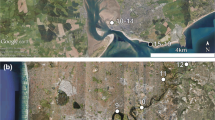Abstract
The distribution and structure of nematode populations in 4 sedimentary environments (muds, muddy sands, fine sands and medium-coarse sands) in Long Island Sound were studied. Mean population densities were highest in muds and muddy sands. Cluster analysis suggested the presence of two basic faunistic units; a mud unit characterized by high species dominance, low species diversity and low species endemism, and a sand unit characterized by low species dominance, high species diversity and high species endemism. Species diversity in all habitats was a direct function of both species richness and equitability. Limited niche separation among deposit feeders, usually the dominant nematode trophic type in muddy sediments, is proposed as the cause for the high species dominance so often characteristic of shallow marine muds. The study afforded the opportunity to examine the quantitative and qualitative aspects of population structure in relation to environmental impact (as indicated by large differences in the heavy metal and organic carbon concentrations within each of the 4 sedimentary regimes). Within each sediment type no differences in population densities, species composition or species diversity of nematodes existed between heavily impacted and apparently non-impacted sediments, or between Long Island Sound and similar coastal regions. These findings cast doubt on (1) the use of heavy metal and organic carbon concentrations as indicators of environmental stress for marine nematodes; (2) the use of diversity indices alone as indicators of environmental deterioration; and (3) the usefulness of field monitoring studies alone for the assessment of pollution impact on marine nematodes.
Similar content being viewed by others
Literature Cited
Boucher, G.: Premieres données ecologiques sur les nematodes libres marins d'une station de vas cotiere de Banyuls. Vie Milieu 23, 69–100 (1973)
Bray, J.R. and J.T. Curtis: An ordination of the upland forest communities of southern Wisconsin. Ecol. Monogr. 27, 325–349 (1957)
Coull, B.C.: Shallow water meiofauna of the Bermuda platform. Oecologia (Berl.) 4, 325–357 (1970)
—: Estuarine meiofauna: a review: trophic relationships and microbial interactions. In: Estuarine microbial ecology, pp 499–512. Ed. by L.H. Stevenson and R.R. Colwell. Columbia: University of South Carolina Press 1973
Field, J.G. and G. McFarlane: Numerical methods in marine ecology. I. A quantitative “similarity” analysis of rocky shore samples in False Bay, South Africa. Zoologica african. 3, 119–137 (1968)
Gerlach, S.A.: Die biozonötische Gliederung der Nematodenfauna an den deutschen Küsten. Z. Morphol. Ökol. Tiere 41, 411–512 (1953)
Heip, C. and W. Decraemer: The diversity of nematode communities in the southern North Sea. J. mar. biol. Ass. U.K. 54, 251–255 (1974)
Jennings, J.B. and A. Deutsch: Occurrence and possible adaptive significance of betaglucuronidase and arylamidase (leucine aminopeptidase) activity in two species of marine nematodes. Comp. Biochem. Physiol. 52A, 611–614 (1975)
Juario, J.V.: Nematode species composition and seasonal fluctuation of a sublittoral meiofauna community in the German Bight. Veröff. Inst. Meeresforsch. Bremerh. 15, 283–337 (1975)
Lorenzen, S.: Die Nematodenfauna der sublitoralen Region der Deutschen Bucht, insbesondere im Titan-Abwassergebiet bei Helgoland. Veröff. Inst. Meeresforsch. Bremerh. 14, 305–327 (1974)
Margalef, R.: Information theory in ecology. Gen. Syst. 3, 36–71 (1958)
McIntyre, A.D.: The ecology of marine meiobenthos. Biol. Rev. 44, 245–290 (1969)
National Marine Fisheries Service: Environmental baselines in Long Island Sound, 1972–1973 Middle Atlantic Coastal Fisheries Center. Informal Report No. 42 (1974) (Copies available from: National Marine Fisheries Service, Sandy Hook Marine Laboratory, Highlands, New Jersey 07732, USA)
Pequegnat, W.E.: Meiobenthos ecosystems as indicators of the effects of dredging. In: Estuarine research, Vol. II. pp 573–584. Ed. by L.E. Cronin. New York: Academic Press 1975
Pielou, E.C.: The measurement of diversity in different types of biological collections. J. theor. Biol. 13, 131–144 (1966)
Slobodkin, L.B. and H.L. Sanders: On the contribution of environmental predictability to species diversity. Brookhaven Symp. Biol. 22, 82–93 (1969)
Tietjen, J.H.: The ecology of shallow water meiofauna in two New England estuaries. Oecologia (Berl.) 2, 251–291 (1969)
—: Ecology and distribution of deep-sea meiobenthos off North Carolina. Deep-Sea Res. 18, 941–957 (1971)
—: Distribution and species diversity of deep-sea nematodes off North Carolina. Deep-Sea Res. 23, 755–768 (1976)
— and J.J. Lee: Axenic culture and uptake of dissolved organic substances by the marine nematode, Rhabditis marina Bastian. Cah. Biol. mar. 16, 685–694 (1975)
——: Feeding behavior of marine nematodes. In: Ecology of marine benthos, pp 22–36. Ed. by B.C. Coull, Columbia: University of South Carolina Press 1977
Ward, A.R.: Studies on the sublittoral freeliving nematodes of Liverpool Bay. I. The structure and distribution of the nematode populations. Mar. Biol. 22, 53–66 (1973)
Warwick, R.M. and J.B. Buchanan: The meiofauna off the coast of Northumberland. I. The structure of the nematode population. J. mar. biol. Ass. U.K. 50, 129–146 (1970)
Wieser, W.: Die Beziehung zwischen Mundhöhlengestalt, Ernährungsweise und Vorkommen bei freilebenden marinen Nematoden. Ark. Zool. (Ser. 2) 4, 439–484 (1953)
—: Benthic studies in Buzzards Bay. II. The meiofauna. Limnol. Oceanogr. 5, 121–137 (1960)
Author information
Authors and Affiliations
Additional information
Contribution no. 100 from the Institute of Marine and Atmospheric Sciences, City College of New York
Communicated by M.R. Tripp, Newark
Rights and permissions
About this article
Cite this article
Tietjen, J.H. Population distribution and structure of the free-living nematodes of Long Island Sound. Mar. Biol. 43, 123–136 (1977). https://doi.org/10.1007/BF00391260
Accepted:
Issue Date:
DOI: https://doi.org/10.1007/BF00391260



